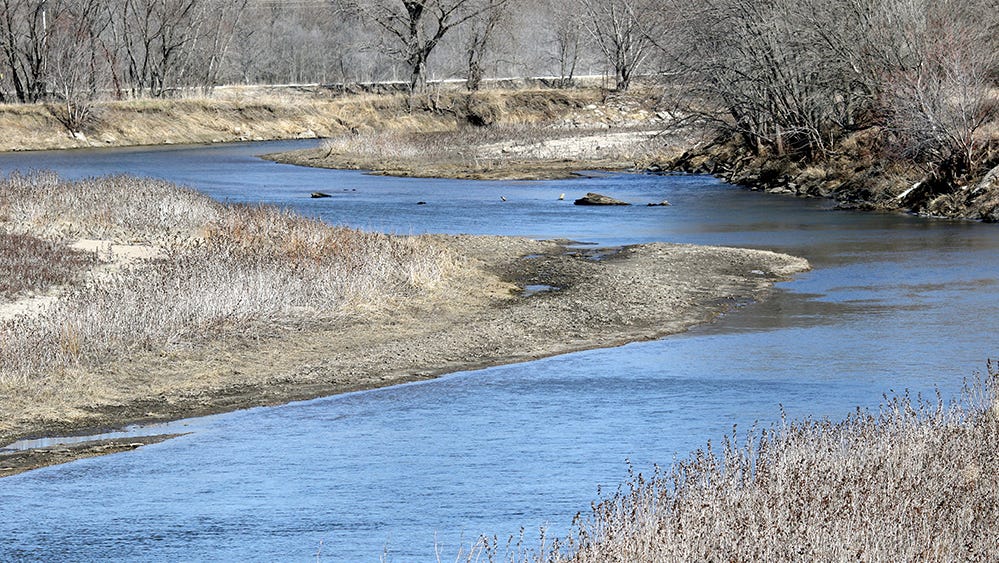A buildup of nitrate in farm fields that likely has resulted from Iowa’s longest-running drought in 70 years has set the stage for a potentially massive uptick in stream pollution, state water-quality observers say.
Research has shown that nitrogen fertilizer that goes unused by crops can quickly be flushed from those fields after a drought year, and Iowa’s drought has endured for more than three.
The nitrate leaching often is most pronounced during significant spring rains, when fields have been fertilized but crops aren’t yet growing.
More:Is Iowa's water cleaner after ten years of state efforts? It depends who you ask.
“These extreme events are quickly becoming the rule,” said Chris Jones, a former University of Iowa researcher who studies agriculture’s effects on water quality. “If and when we return to this wet regime, it’s going to be epic.”
An example: In 2013, record spring rainfall lifted the state from one of its worst droughts. The result was a more than 400% increase in the amount of nitrate detected in Iowa streams in 2012 and 2013, according to data collected by the Iowa Nutrient Research Center.
With stream flow data taken into account, 2013 was nearly the worst year in two recent decades for nitrate pollution. The absolute amount of nitrate in streams statewide trended upward until 2016.
Climate predictions show this spring might be warmer and wetter than normal, State Climatologist Justin Glisan said. That increases the likelihood of thunderstorms and heavier rainfalls, but he said it’s impossible to say whether this spring will mimic 2013.
Nitrogen is a key nutrient for Iowa corn to ensure maximum crop yields. It often is added to fields with synthetic fertilizers and livestock manure.
But it poses environmental threats beyond the fields. Rivers are a significant source of drinking water for large cities — notably those in the Des Moines metro — and nitrate must sometimes be removed from that water to make it safe to drink. Des Moines Water Works spent about $150,000 on nitrate removal in 2022.
Further, elevated levels of nitrate and another prominent nutrient — phosphorus — can wreak havoc on aquatic ecosystems, leading to algae blooms that diminish oxygen in the water and release toxins that are harmful to swimmers.
The crop fertilizers are leading contributors to the Gulf of Mexico’s dead zone at the mouth of the Mississippi River, which drains much of Iowa.

Research has shown that nitrogen fertilizer that goes unused by crops can quickly be flushed from those fields after a drought year, and Iowa’s drought has endured for more than three.
The nitrate leaching often is most pronounced during significant spring rains, when fields have been fertilized but crops aren’t yet growing.
More:Is Iowa's water cleaner after ten years of state efforts? It depends who you ask.
“These extreme events are quickly becoming the rule,” said Chris Jones, a former University of Iowa researcher who studies agriculture’s effects on water quality. “If and when we return to this wet regime, it’s going to be epic.”
An example: In 2013, record spring rainfall lifted the state from one of its worst droughts. The result was a more than 400% increase in the amount of nitrate detected in Iowa streams in 2012 and 2013, according to data collected by the Iowa Nutrient Research Center.
With stream flow data taken into account, 2013 was nearly the worst year in two recent decades for nitrate pollution. The absolute amount of nitrate in streams statewide trended upward until 2016.
Climate predictions show this spring might be warmer and wetter than normal, State Climatologist Justin Glisan said. That increases the likelihood of thunderstorms and heavier rainfalls, but he said it’s impossible to say whether this spring will mimic 2013.
Nitrogen is a key nutrient for Iowa corn to ensure maximum crop yields. It often is added to fields with synthetic fertilizers and livestock manure.
But it poses environmental threats beyond the fields. Rivers are a significant source of drinking water for large cities — notably those in the Des Moines metro — and nitrate must sometimes be removed from that water to make it safe to drink. Des Moines Water Works spent about $150,000 on nitrate removal in 2022.
Further, elevated levels of nitrate and another prominent nutrient — phosphorus — can wreak havoc on aquatic ecosystems, leading to algae blooms that diminish oxygen in the water and release toxins that are harmful to swimmers.
The crop fertilizers are leading contributors to the Gulf of Mexico’s dead zone at the mouth of the Mississippi River, which drains much of Iowa.

Iowa primed for potentially ‘epic’ increase in stream pollution, researcher warns
An ex-UI researcher says a buildup of nitrate in farm fields during three years of drought could flood into Iowa's streams during spring rains
www.press-citizen.com

